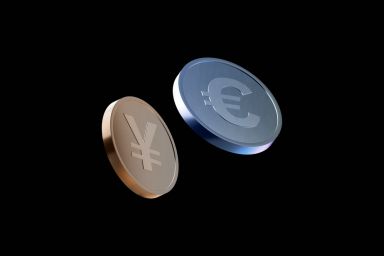EUR/JPY
What is the EUR/JPY currency pair?
The EUR/JPY currency pair is formed from the Eurozone’s euro and the Japanese yen. This currency pair, is so-named as it does not include the US dollar; the euro is the base currency and the yen is counter currency. The economies of Japan and Europe are becoming increasingly interconnected, and so the EUR/JPY rate has acquired considerable importance in the FX market. Boasting a high trading volume, it is one of the strongest currency pairs that does not include the USD.
All about the euro
The euro is the official currency of the European Union (EU), it is used by 19 of the 28 European Union countries, known as the Eurozone. Symbolised by the sign €, the currency was introduced on 1 January 1999 under the management of the European Central Bank (ECB). However, it was not until three years later, in 2002, that the currencies banknotes and coins came into common use across Europe.
On 1 January 2002, an initial 12 EU countries adopted the euro, replacing their national currencies. These countries were: Austria, Belgium, Finland, France, Germany, Greece, Ireland, Italy, Luxembourg, the Netherlands, Portugal and Spain.
Today, a total of 19 EU member states hold the euro as their national currency, with the remainder, excluding the UK, committing to do so in the future. Additionally, a number of non-euro states have fixed their currencies to the value of the euro, these include the Danish krone, the Comorian franc and the Moroccan dirham.
The euro is the second most traded currency, in terms of volume, after the USD, with the Eurozone’s economy ranked second globally.
What’s the story behind the Japanese yen?
Introduced to Japan in the New Currency Act of 1871 by the Meiji government, the yen is the official currency of Japan. The name means ‘circle’, and the currency was developed to create a standardised measurement of currency for the nation after the Edo Period system.
In doing so, Japan began to use the gold standard measurement employed across Europe, as the new yen was tied to the weight of gold – 1.5 g – and silver – 24.26 g. To regulate and mint the newly introduced currency, the Bank of Japan was founded.
Over its history, the yen has seen periods of appreciation and depreciation. One significant period occurred after the second world war, the yen experienced a significant downturn and introduced a fixed exchange rate. By 1971, the currency had risen in value and was allowed to float.
Although it continues to be floated today, the currency is considered to be controlled, with strict government currency intervention. As of 2018, the Japanese yen is the third most traded currency in the world and acts as an anchor or reserve currency, after the USD, EUR and GBP.
What influences the EUR/JPY pair?
The EUR/JPY currency pair is influenced by a number of factors, including:
Economics and politics. Changes to the economic policy and status of the respective countries has a direct correlation to this currency pair. Official releases from financial institutions, such as the European Central Bank (ECB) or the Bank of Japan, relating to monetary policy, interest rates, among others create volatility for the EUR/JPY.
Imports and exports. With Japan’s economy heavily balanced on successfully exports, the balance of imports to exports is highly influential to the country’s economic strength.
Instability. Disruptions, in any form, can cause this currency pair some trouble. Whether it be natural disasters, economics or political instability. Major influences in the last few years include Japan’s 2011 combo disaster of an earthquake, causing a tsunami and nuclear disaster, while the Eurozone has been affected by a debt-crisis since 2009.
How to trade EUR/JPY?
Explore Capital.com to keep up-to-date with the latest changes to the EUR/JPY share price. Get current updates on the cross pair with the EUR/JPY charts and trade this powerful world currency pair.
